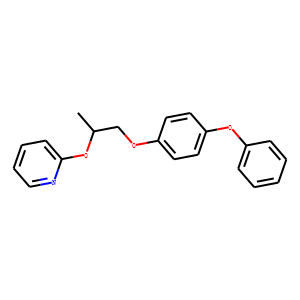| Reference | <div>
1. Toxics. 2020 Mar 13;8(1):20. doi: 10.3390/toxics8010020.Fate of Pyriproxyfen in Soils and Plants.Devillers J(1).</div>
<div>
</div>
<div>
Since the 1990s, the insect growth regulator pyriproxyfen has been widely used worldwide as a larvicide in vector control and in agriculture to fight a very large number of pests. Due to its widespread use it is of first importance to know how pyriproxyfen behaves in the terrestrial ecosystems. This was the goal of this work to establish the fate profile of pyriproxyfen in soils and plants. Thus, in soil, pyriproxyfen photodegrades slowly but its aerobic degradation is fast. The insecticide presents a high tendency to adsorb onto soils and it is not subject to leaching into groundwater. On the contrary its two main metabolites (4'-OH-Pyr and PYPAC) show a different fate in soil. When sprayed to plants, pyriproxyfen behaves as a translaminar insecticide. Its half-life in plants ranges from less than one week to about three weeks. The review ends by showing how the fate profile of pyriproxyfen in soils and plants influences the adverse effects of the molecule on non-target organisms.</div>
<div>
</div>
<div>
2. PLoS Negl Trop Dis. 2017 Jul 17;11(7):e0005651. doi: 10.1371/journal.pntd.0005651. eCollection 2017 Jul.Community effectiveness of pyriproxyfen as a dengue vector control method: A systematic review.Maoz D(1)(2), Ward T(3), Samuel M(4), Müller P(1)(2), Runge-Ranzinger S(4), Toledo J(5), Boyce R(6), Velayudhan R(7), Horstick O(4).</div>
<div>
</div>
<div>
BACKGROUND: Vector control is the only widely utilised method for primary prevention and control of dengue. The use of pyriproxyfen may be promising, and autodissemination approach may reach hard to reach breeding places. It offers a unique mode of action (juvenile hormone mimic) and as an additional tool for the management of insecticide resistance among Aedes vectors. However, evidence of efficacy and community effectiveness (CE) remains limited.</div>
<div>
<br />
OBJECTIVE: The aim of this systematic review is to compile and analyse the existing literature for evidence on the CE of pyriproxyfen as a vector control method for reducing Ae. aegypti and Ae. albopictus populations and thereby human dengue transmission.</div>
<div>
<br />
METHODS: Systematic search of PubMed, Embase, Lilacs, Cochrane library, WHOLIS, Web of Science, Google Scholar as well as reference lists of all identified studies. Removal of duplicates, screening of abstracts and assessment for eligibility of the remaining studies followed. Relevant data were extracted, and a quality assessment conducted. Results were classified into four main categories of how pyriproxyfen was applied: – 1) container treatment, 2) fumigation, 3) auto-dissemination or 4) combination treatments,-and analysed with a view to their public health implication.</div>
<div>
<br />
RESULTS: Out of 745 studies 17 studies were identified that fulfilled all eligibility criteria. The results show that pyriproxyfen can be effective in reducing the numbers of Aedes spp. immatures with different methods of application when targeting their main breeding sites. However, the combination of pyriproxyfen with a second product increases efficacy and/or persistence of the intervention and may also slow down the development of insecticide resistance. Open questions concern concentration and frequency of application in the various treatments. Area-wide ultra-low volume treatment with pyriproxyfen currently lacks evidence and cannot be recommended. Community participation and acceptance has not consistently been successful and needs to be further assessed. While all studies measured entomological endpoints, only two studies measured the reduction in human dengue cases, with inconclusive results.</div>
<div>
<br />
CONCLUSIONS: Although pyriproxyfen is highly effective in controlling the immature stages of dengue transmitting mosquitoes, and-to a smaller degree-adult mosquitoes, there is weak evidence for a reduction of human dengue cases. More well designed larger studies with appropriate standardised outcome measures are needed before pyriproxyfen is incorporated in routine vector control programmes. Additionally, resistance to pyriproxyfen has been reported and needs investigation.</div>
<div>
</div>
<div>
3. Arch Insect Biochem Physiol. 2020 Mar;103(3):e21615. doi: 10.1002/arch.21615. Epub 2019 Sep 10.The juvenile hormone receptor as a target of juvenoid "insect growth </div>
<div>
regulators".Jindra M(1), Bittova L(1).</div>
<div>
</div>
<div>
Synthetic compounds that mimic the action of juvenile hormones (JHs) are founding members of a class of insecticides called insect growth regulators (IGRs). Like JHs, these juvenoids block metamorphosis of insect larvae to reproductive adults. Many biologically active juvenoids deviate in their chemical structure considerably from the sesquiterpenoid JHs, raising questions about the mode of action of such JH mimics. Despite the early deployment of juvenoid IGRs in the mid-1970s, their molecular effect could not be understood until recent discoveries of JH signaling through an intracellular JH receptor, namely the ligand-binding transcription factor Methoprene-tolerant (Met). Here, we briefly overview evidence defining three widely employed and chemically distinct juvenoid IGRs(methoprene, pyriproxyfen, and fenoxycarb), as agonist ligands of the JH receptor. We stress that knowledge of the target molecule is critical for using these compounds both as insecticides and as research tools.</div>
<div>
</div>
|

